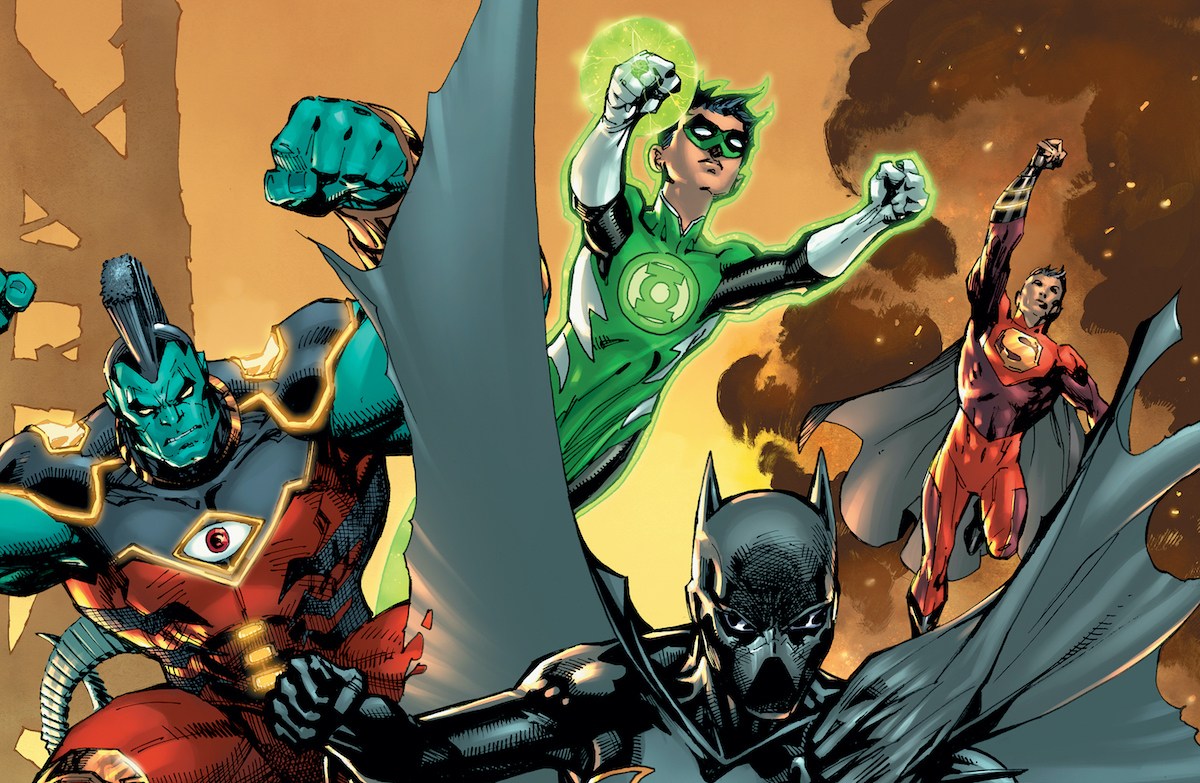Table of Contents Show
May in the U.S. was Asian-American Pacific Islander (AAPI) month, prompting DC to release its first-ever Asian superhero anthology special: DC Festival of Heroes: The Asian Superhero Celebration #1. Released on May 11th, the special features eleven different stories in its whopping one-hundred pages of content. With an introduction by writer Jeff Yang and a callout page at the end addressing Asian hate, the volume confronts social issues of the day head-on while also recognizing the general potency of its stories within the larger historical zeitgeist.
What makes this anthology particularly successful is its expression of and reflection on the diversity of Asian experiences, presenting readers with a variety of characters and situations that still strike the reader as recognizable while being unique to each story. As such, the heroes the writers and artists explore come from a wide range of cultural contexts and encounter a plethora of issues, some distinctly ethnic while others are shown to be more personal. And even though they are set in a universe much more extraordinary than our own, the fantastical and heroic elements do not overshadow the lessons each story serves up. Instead, they integrate beautifully into each character’s backstory and situation and very often strengthen the takeaways the panels illustrate. Here are just some of the thoughtful and powerful stories included.
“Sounds”
Written by Mariko Tamaki, drawn by Marcus To, colored by Sebastian Cheng, and lettered by Janice Chiang, the first story in the AAPI-month special follows Cassandra Cain (Batgirl) as she rescues a scientist from a gang of thugs. Though she is a lethal warrior, already in the first panel of the story, we find out Cassandra’s few weaknesses are her ability to express herself. Some backstory reveals that her father literally trained her not to speak to further her proficiency as an assassin. In the final pages of the story, we see her make an attempt to overcome this impediment by speaking to the cute scientist she rescued, who is also Asian.
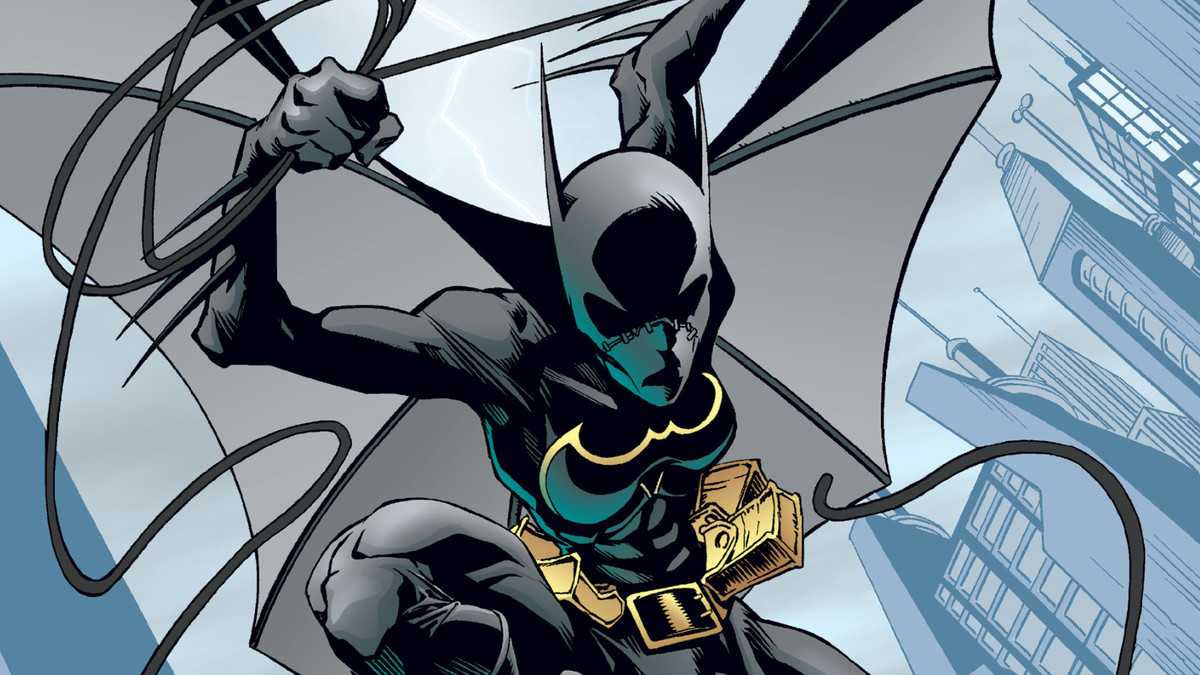
Peterson, Scott; Puckett, Kelley. “Batgirl Vol 1.” DC. 20 Jan. 2016.
This story about Cassandra is short and sweet, cutting through Batgirl’s normally tough and dark veneer to showcase her as just another girl trying to express herself and win over a boy. Her difficulty in speaking is only a slight magnification of a common issue for Asian (and non-Asian) adolescents — finding ways to truly express themselves. Her difficulty with speaking also touches on a popular stereotype of Asians as a meek, silent minority group. Cassandra’s efforts to overcome this inhibition represent a defiance of this stereotype and its mischaracterization of Asians.
“Dress Code”
Written by Minh Lê, drawn and colored by Trung Le Nguyen, and lettered by Aditya Bidikar, this story follows Tai Pham (Green Lantern) and a conversation he has with his grandmother. It begins in the midst of a battle against Yellow Lantern Arkillo, who, right after knocking Tai into a rock, makes fun of his áo dài outfit. This sequence cuts straight into a similar instance when a food service worker also makes fun of his outfit while Tai eats with his grandmother. His grandmother, in turn, reflects on her own experiences with strangers making fun of her clothing, reminding Tai of its importance to their ethnic identity and asking him, “Why fit in when you can stand out?” (( Lê, M. DC Festival Of Heroes: The Asian Superhero Celebration #1. Burbank: DC Comics, 2021 )). Tai echoes his grandmother’s wisdom as he subdues Arkillo and showcases his pride in his Vietnamese heritage, no matter how it may look to others.
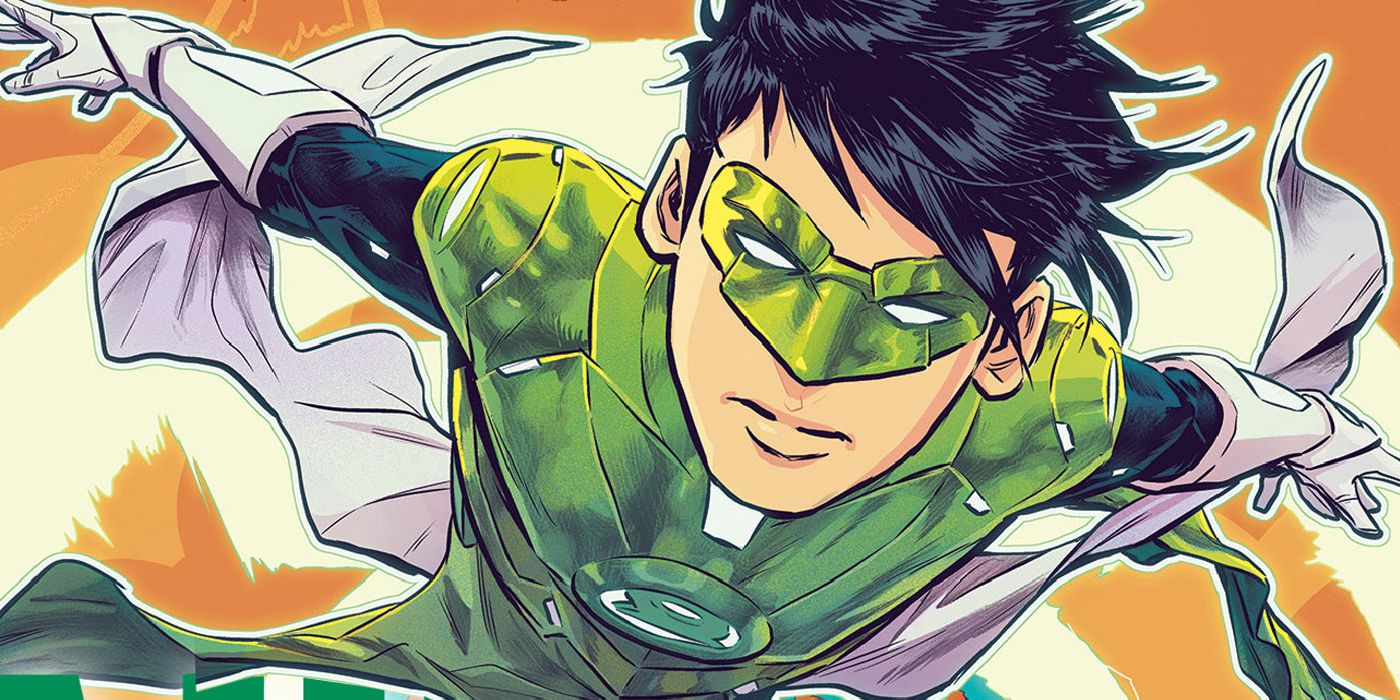
Tong, Andie; Lê, Minh. Green Lantern: Alliance. DC. 5 Apr. 2022.
In a general sense, this story reflects a common issue of cultural alienation and the popular emasculation of Asian males. However, what’s admirable about Lê’s approach to this second issue is that he doesn’t try to push Tai’s portrayal to the opposite end of the gendered spectrum. Instead, he refocuses the issue on Tai’s ethnic heritage and his reclamation of that identity, which is more crucial to the anthology’s themes than a more typical youth masculinization story.
“Hawke & Kong”
This next story, written by Greg Pak, drawn by Sumit Kumar, colored by Romulo Fajardo Jr., and lettered by Steve Wands, does an excellent job of exploring how Asian cultures can clash but also find common ground. It follows Connor Hawke (Green Arrow) as he brings home a kimchi package to his family. Unexpectedly, Kenan Kong (New Super-Man) drops in and reveals he’s protecting Metropolis in Superman’s absence. A battle ensues between Kong and a mechanized dragon, which counts the kimchi delivery among its collateral. Though Connor goes home dejected and frustrated, Kenan comes over bearing a container of pao cai, which he offers as a replacement for the kimchi. Connor’s grandmother invites Kenan in, and he eats at the table with Connor’s mother and grandmother.
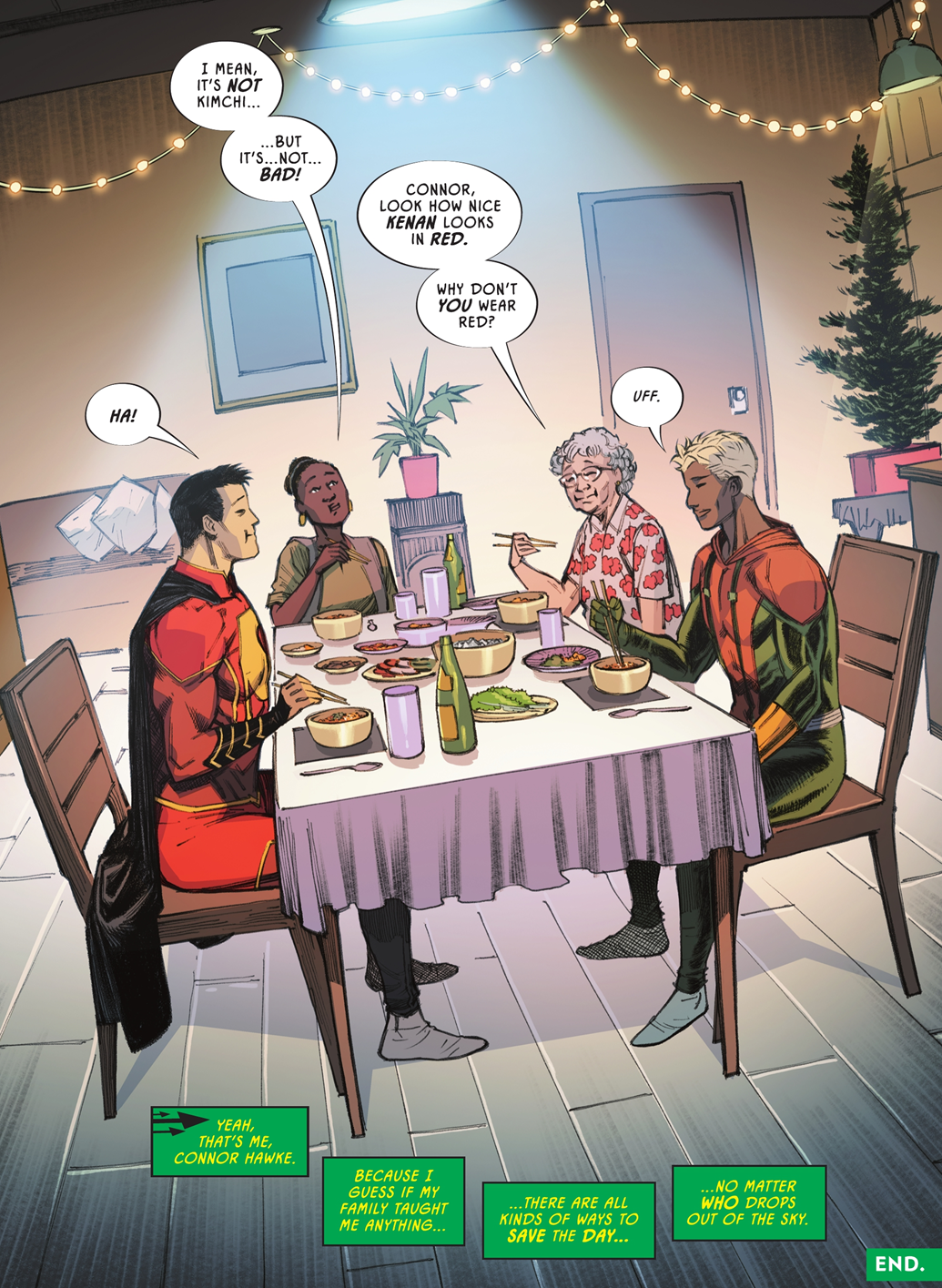
Pak, Greg. “Hawke & Kong.” DC Festival Of Heroes: The Asian Superhero Celebration #1. DC. 11 May. 2021.
Though it doesn’t end up playing a large role in the story, Connor’s mixed heritage — he is black, white, and Korean — is itself excellent fodder for explorations of racial identity. But the main tensions in the story come from Connor’s and Kenan’s relationship. Connor is Korean, and Kenan is Chinese; it just so happens that their differences extend beyond their race. Kenan’s bravado and cockiness seem to match his more physical power as he takes on the dragon head-on. However, Connor’s more measured and observant nature makes him indispensable during the fight, whether by protecting civilians from Kenan’s debris or protecting Kenan himself from a blindsided attack.
Though their ethnicities are only superficial details in this sequence, Pak clearly illustrates that they are far from alike while they are both Asian. It’s an appreciable distinction to make, showing not only that the Asian experience is different between nationalities but that Asian cultures can clash as well. However, from their differences, some similarities remain. Kenan’s delivery of pao cai to Connor’s apartment shows a flawed but genuine attempt to bridge this cultural rift. His assertion that pao cai is better than kimchi showcases his aforementioned arrogance and bluster, but his attempt to find the closest equivalent to the kimchi dish in his own culture shows an honest desire to understand and relate to Connor’s heritage. This culminates in Kenan eating dinner with Connor’s family, a powerful symbol of coming together and compassion not only in Chinese and Korean cultures but globally.
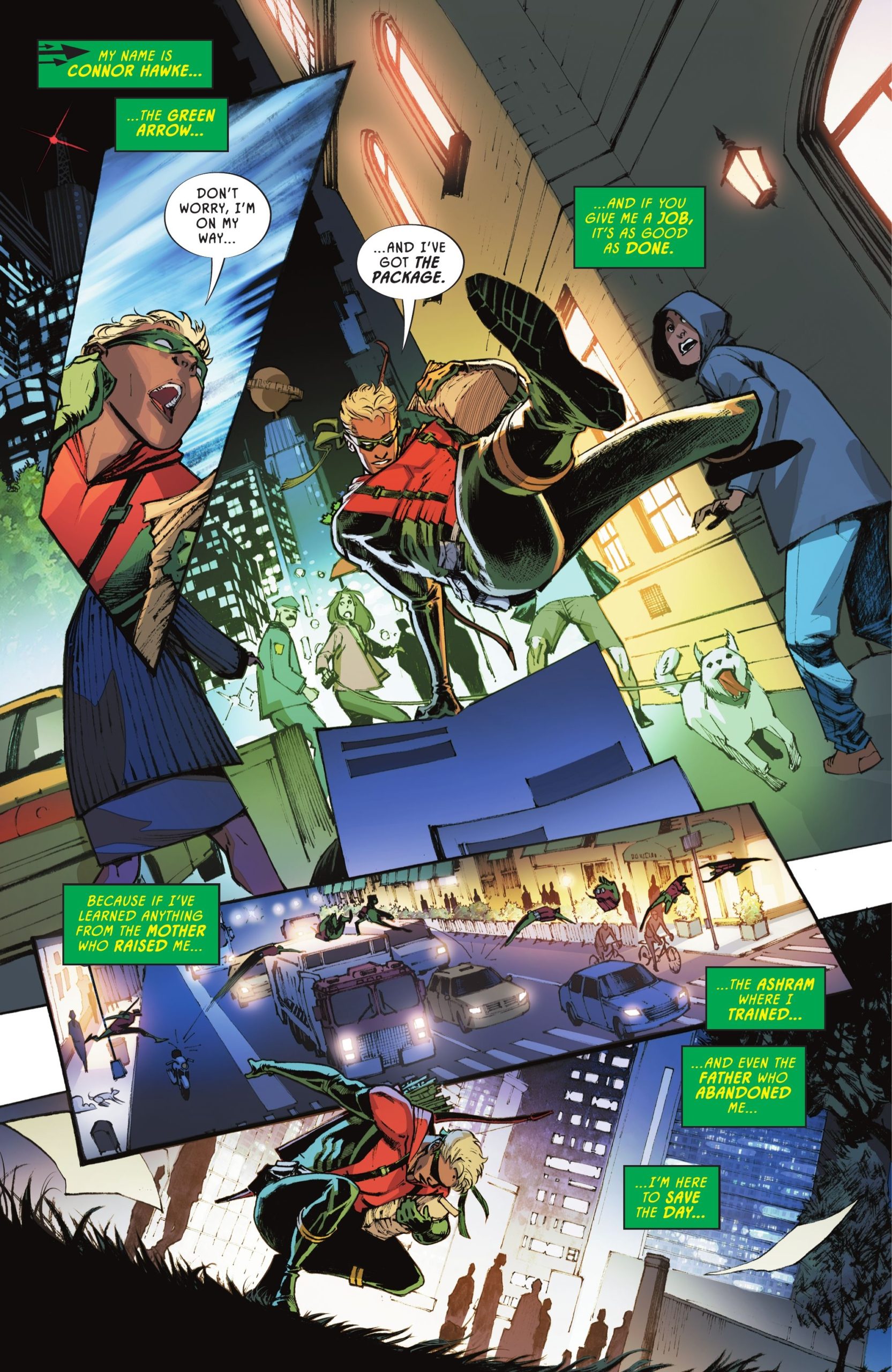
As he explains it to Connor, Kenan’s situation also briefly touches on a different aspect of the Asian experience. Despite his showboating and confident facade, he doesn’t actually know anyone else in Metropolis. It’s hard not to find a loose comparison between Kenan and the “lonely immigrant in another country,” seeking community and kindness when they’re not working. The Hawke family’s acceptance of Kenan into their home can also become an image of solidarity between two immigrant communities. Overall, “Hawke & Kong” is an excellent portrayal of the diversity of Asian cultures, even in an anthology about the ubiquity of many Asian experiences.
“Masks”
This story, written by Ram V, drawn by Audrey Mok, colored by Jordie Bellaire, and lettered by Tom Napolitano, introduces us to a lesser-known, newer character to the DC Universe: Lian “Shoes” Harper, daughter of Cheshire and Arsenal. The first page is especially effective with its panel art demonstrating Lian’s lack of cultural and personal history. Images of a birthday cake, a dancing lion, and red lanterns strung above the street are brilliantly veiled from reality by orange speckling, coding the panels into a life that she could’ve but ultimately did not have. Not only do they offer tantalizing glimpses into a normal childhood, but they specifically point out her lack of interaction with her Vietnamese heritage. First, we witness a reimagining of Cheshire delivering Lian from danger when she’s a little girl, followed by a present-day transition into Lian donning a similar mask to Cheshire and attacking a gang of robbers.
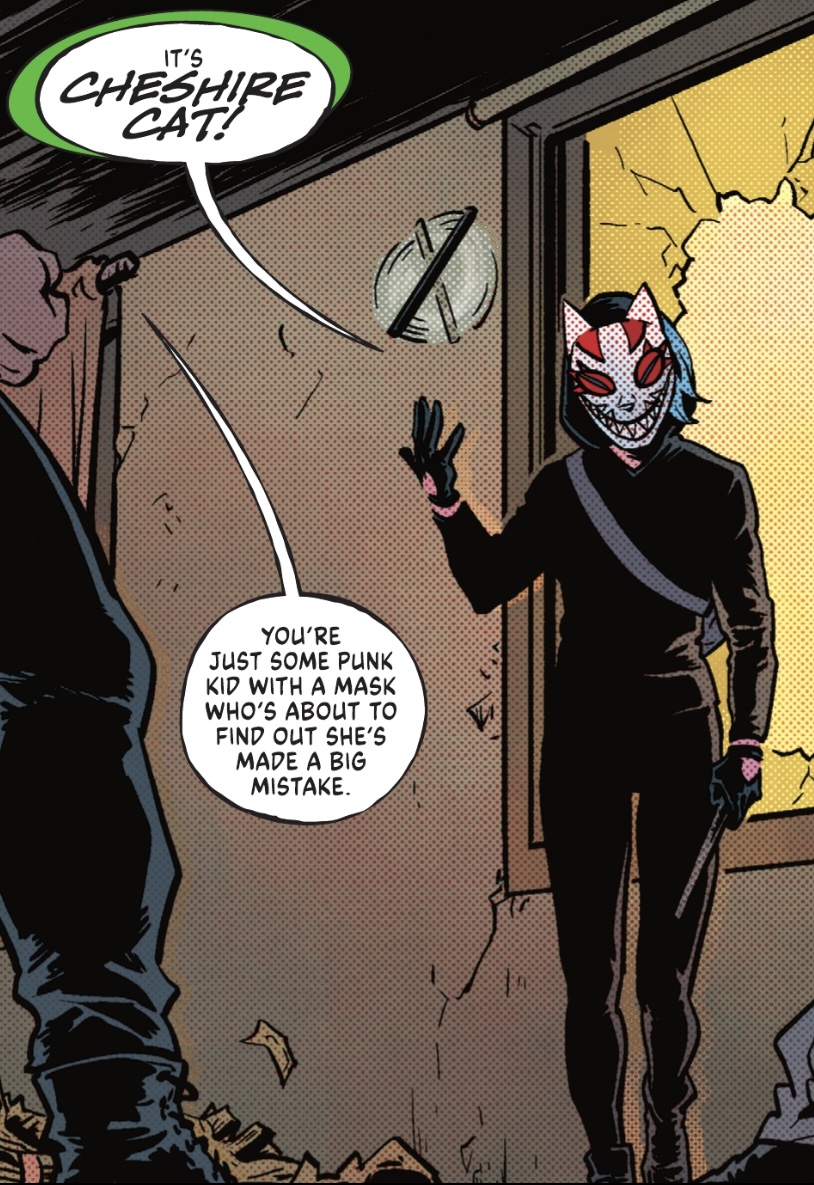
V, Ram. “Masks.” DC Festival Of Heroes: The Asian Superhero Celebration. DC. 11 May. 2021.
Already, this theme of legacy and heritage that has influenced stories beforehand crops up here as we witness Shoes seemingly trying to emulate her mother and rescuer as she takes down this gang of thieves. However, as Lian, in her “Cheshire Cat” guise, suddenly loses the upper hand to a thug, she steps in her current parental figure/guardian: Selina Kyle (Catwoman). As we learn that Selina has been training her and presumably raising her to an extent, the name “Cheshire Cat” seems to take on more meaning. It seems to integrate the identities of the women Lian owes her life to — Cheshire and Catwoman. Therefore, her name and vigilantism seem to represent some honoring of her heritage and upbringing.
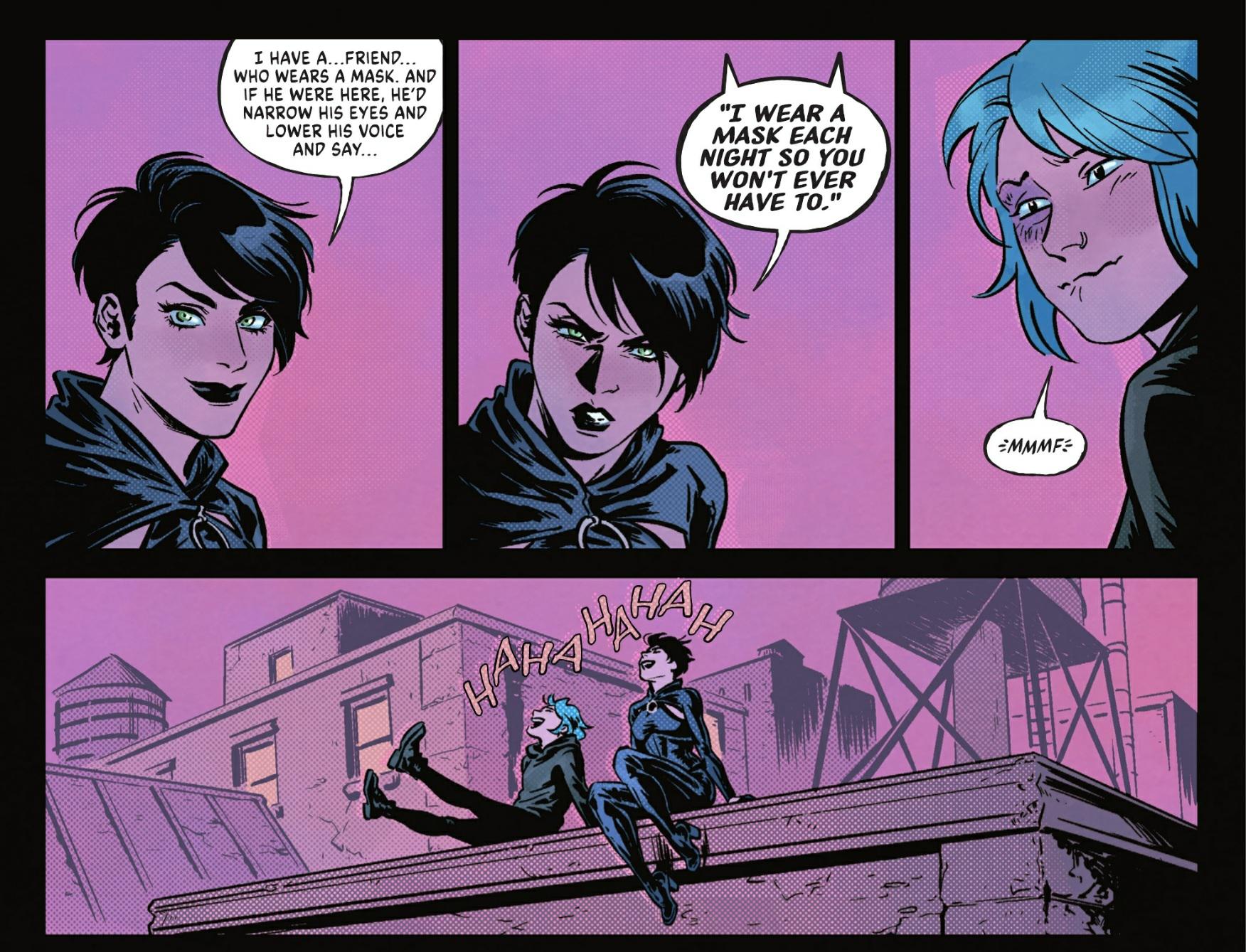
These struggles with and questions of identity culminate in a conversation between Shoes and Selina on a rooftop. Among the poignant bits of advice Selina gives is this: “Sometimes the masks we wear are meant to show the world who we really are” (( V, R. DC Festival Of Heroes: The Asian Superhero Celebration #1. Burbank: DC Comics, 2021 )). In the larger context of the anthology, Selina’s words speak to the normalcy of found identity. Though Shoes is literally still trying to find her past and identity, it doesn’t have to define her. Similarly, though ethnic identity may be important to an individual, it doesn’t have to define them, nor should it restrict how one expresses themselves. Ethnic identity can be important, but as in Lian’s case, the identity you were born with doesn’t necessarily have to be the one you end up with.
“Family Dinner”
Written by Alyssa Wong, penciled in by Sean Chen, inked by Norm Rapmund, colored by Rain Beredo, and lettered by Ariana Maher, “Family Dinner” is an excellent reimagining of the “meet the father” trope in romantic plot lines. Grace Choi is dating Anissa Pierce (Thunder), daughter of Jefferson Pierce, the famous Black Lightning. She’s nervous about meeting him at dinner, and it turns out her fears are partially justified, at least at first. He doesn’t think Grace is good enough for his daughter, and as an argument begins to brew, they’re suddenly interrupted by supervillains Mammoth and Shimmer attacking the restaurant.
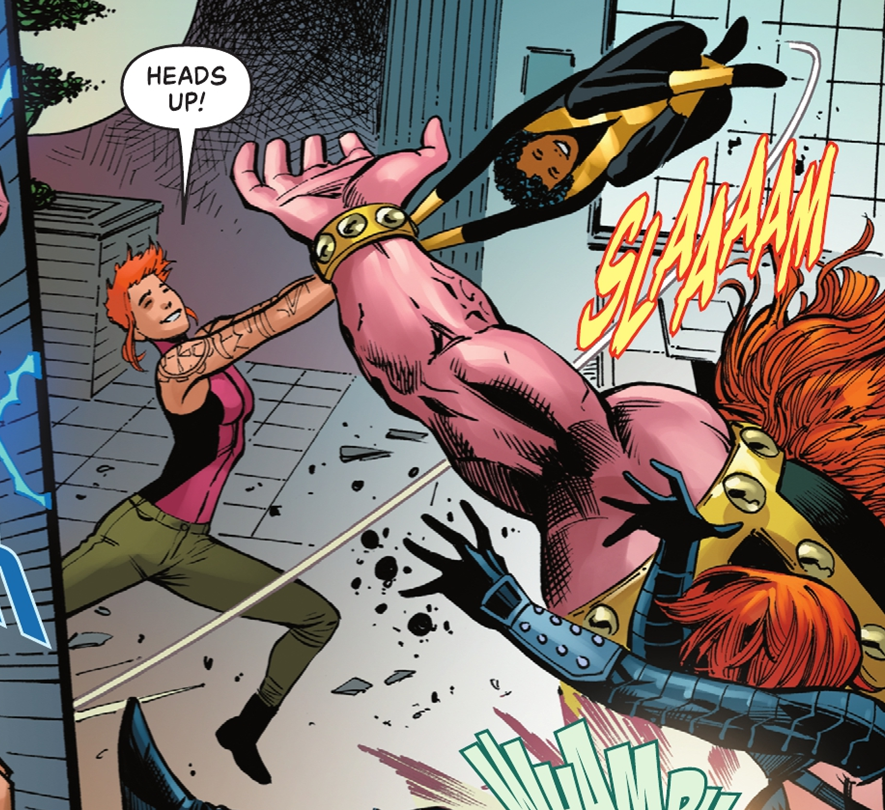
This was a really smartly written story. First off, it twists the convention of the nervous date meeting their partner’s parents in several unique and meaningful ways. Black Lightning plays the part of a lofty, highly-respected parent that Grace is seeking to charm, and in a small way, wants the approval of. Grace herself is made out to be a “bad boy” by Jefferson Pierce, matched by her sleeveless t-shirt, superphysical power set, and her general life history. Funnily enough, Jefferson calls her out for eating “sushi” with her hands, and she defends herself by correcting him that onigiri is meant to be eaten without utensils.
What’s also remarkable about the way the story is written is that Anissa’s and Grace’s lesbian relationship is not actually the point of conflict in the story. Wong does a great job in utilizing this Asian character to twist the conventions in the story, whether it be Grace’s insecurities about being “all body, no brains” or her portrayal as a bad influence on Anissa. Of course, Grace wins Jefferson’s approval by the end of the night, but not without a really well-formulated journey towards it. And thematically aside, almost every panel Jennifer Pierce (Lightning) is in is worth a chuckle, providing some respite from the heavier content of the main story.
“Kawaii Kalamity!”
This story, written by Sarah Kuhn, lettered again by Ariana Maher, and with art by Victoria Ying, is about a bad dream Emiko Queen (Red Arrow) has. The most outstanding aspect of the story is the art style. Dominated by soft, pastel colors and bounded by still soft, rounded edges, this story strikes one as much more cartoonish than the other stories in the anthology. Indeed, much of this has to do with the content — Emiko is stuck in a kawaii dreamscape, populated by a chubby purple squirrel and other adorable rodents. The situation is overall very comical, whether it be with the squirrel catching Emiko’s arrow and transforming it into something cuter or when it offers Emiko stickers shaped like mochi (( Kuhn, S. DC Festival Of Heroes: The Asian Superhero Celebration #1. Burbank: DC Comics, 2021 )). With the art and the story, it’s a delightful change of pace from the other art styles and stories of the anthology, diverse as they may be.
Nonetheless, the story’s themes still pack a solid punch. Emiko makes it known from the very start that she’s “been through a lot,” including being “Kidnapped at birth! Raised by an assassin!” and her mother trying to kill her (( Kuhn, S. DC Festival Of Heroes: The Asian Superhero Celebration #1. Burbank: DC Comics, 2021 )). These details are given so nonchalantly and are so out of place even in the first two panels that it’s hard to feel their gravity. Nonetheless, they speak to the trauma Emiko carries in this kawaii setting — or at least part of that trauma. Because from the squirrel’s and the woodland rodents’ pestering, Emiko finally reveals that she “hates cute.” She further reveals that “people always try to call me cute! Or assume I like cute things because I’m Japanese!” (( Kuhn, S. DC Festival Of Heroes: The Asian Superhero Celebration #1. Burbank: DC Comics, 2021 )). When the squirrel follows up with a question about what Emiko herself feels in this very brief therapeutic session, Emiko begins to tirade further about her hatred of kawaii and cuteness. Then she espies a plush model of her hugging the squirrel. And upon waking, she unabashedly hugs this plushy close as she returns to her nap.
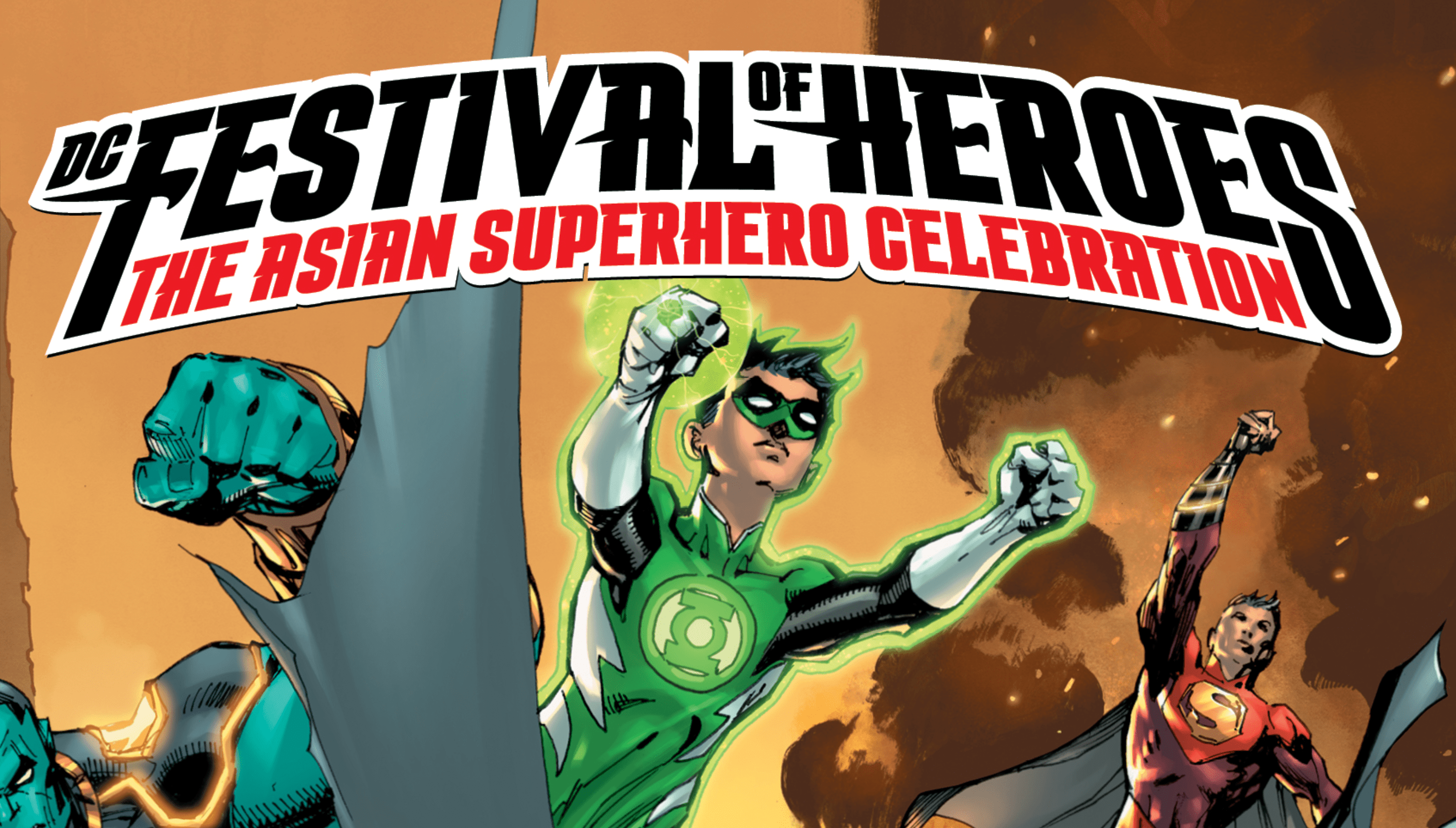
Though it reads as a pretty straightforward story, Emiko’s nap contains some pretty powerful revelations. On the one hand, she “hates” kawaii and cuteness. On the other hand, she is the Red Arrow, deadly and toughened from her past, and couldn’t possibly have an appreciation for softness and fluffiness. Not only are those concepts seemingly mutually exclusive from the exterior she maintains, but she has her own personal reasons for disliking these things: they’ve become a stereotype for Japanese people. Even through the literally dreamy lens of this cutesy story, Emiko is dealing with a pervasive and serious problem regarding ethnic alienation and racism: stereotyping. When certain concepts — such as kawaii — become synonymous with a single culture and its people, the stereotype reduces those people to merely those concepts they’re associated with.
What’s more is that in this story, it even seems those concepts are being misappropriated and redefined by the people Emiko has had encounters with. Whatever cultural significance or meaning they had is twisted by other parties. Understandably, up until now, Emiko has therefore been repulsed by this cultural appropriation and stereotyping, further removing kawaii and all its associations from her identity. But in the end, Emiko’s consideration of the squirrel’s sage inquiries and her literal awakening to reality leads her to discard this emotional baggage and literally embrace “cuteness.” The powerful final image of her — laying snug on the sofa, clutching the plushy to her chest with her mask still on and a smile on her face — drives home a similarly hopeful and empowering message to the reader. This is a moment of defiance and reclamation for Emiko: she resists definition and circumscription by others and reclaims this part of her personal and ethnic identity. So what if she likes cute things and she’s Japanese? Only she decides what truly defines her.
The Anthology’s Responsibility
Each of the eleven stories can tackle or address different facets of Asian culture and how Asian identity is compared to or clashes with other national identities. Jeff Yang’s introduction to the collection touches on many of the themes in those stories to come, from “culture shock” to “struggles with self-expression,” but also the especial timeliness of the collection’s publication: “at a time when Earth has been invaded by a microscopic swarm… when Asian Americans have been beset by a much more familiar horror of xenophobia, bigotry, and assaults” (( Yang, J. DC Festival Of Heroes: The Asian Superhero Celebration #1. Burbank: DC Comics, 2021 )). From the get-go, the creators involved in this special make it clear that they understand the significance of what they’re publishing in its historical context. This arguably makes it all the more important that the themes they explore are not just specific to the past year’s global rise in Asian hate but are recognizable from situations beyond the year to Asians of various ages and backgrounds.
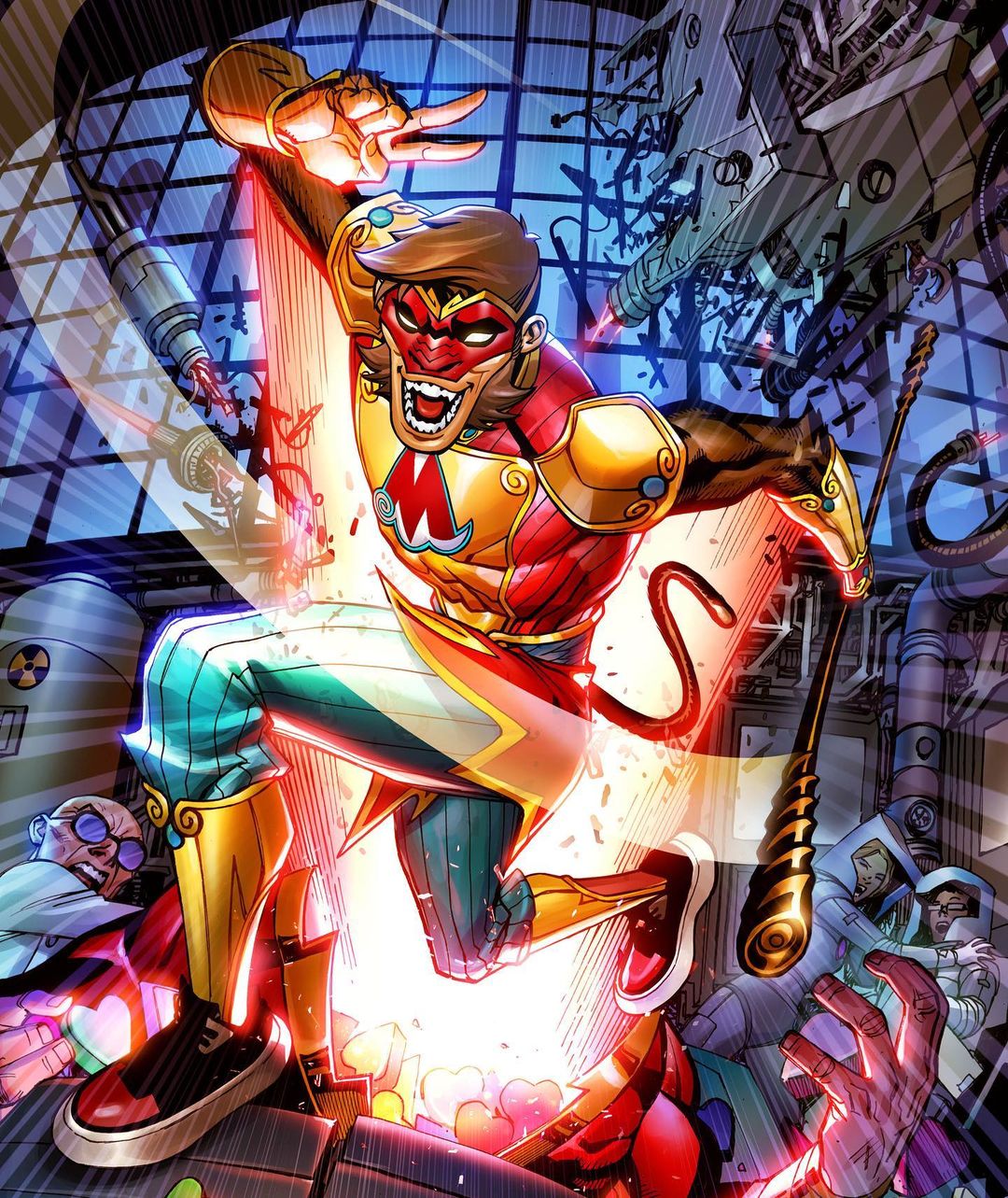
Though explicitly written to celebrate Asian pride in a time of intensified hatred towards Asians domestic and abroad, the anthology’s greatest strength is not in its celebration of Asian cultures themselves. Nor does it necessarily portray the quintessential “Asian experience” in each story. Instead, the anthology shines the most in its character diversity and the range of experiences and problems each one has. From the prodigal son of Batman, Damian Wayne, to the more recently introduced daughter of Cheshire and Arsenal, Lian Harper, each character deals with issues that aren’t inherently “Asian.” That’s what’s most beautiful about this anthology: these stories aren’t just about superheroes being Asian. They’re about Asian superheroes and their human experiences, where their heritage isn’t minimized to just a passing detail, but neither is it heavy-handedly written in to make a cliche statement about ethnic pride.
